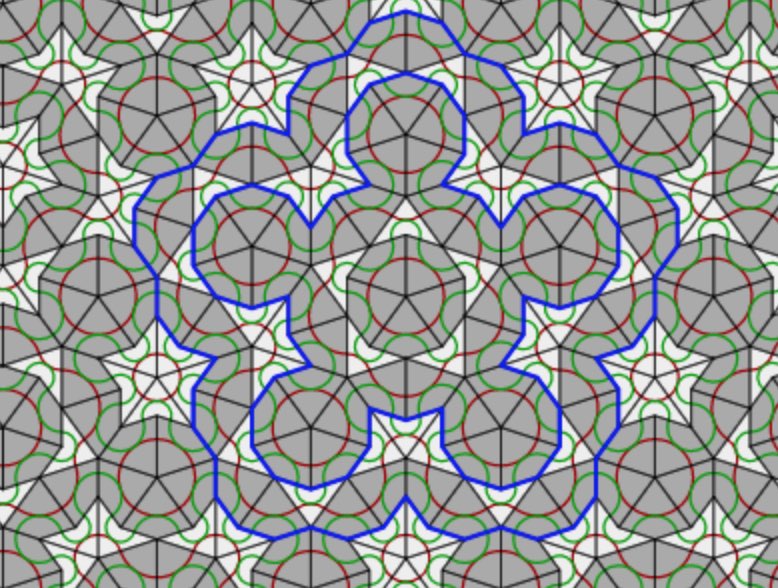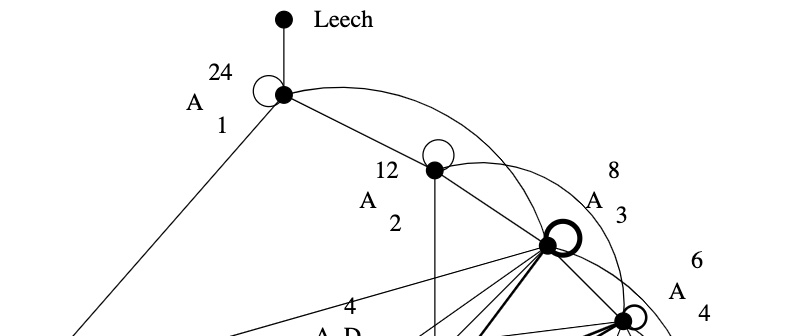Last time we’ve seen that de Bruijn’s pentagrids determined the vertices of Penrose’s P3-aperiodic tilings.
These vertices can also be obtained by projecting a window of the standard hypercubic lattice Z5 by the cut-and-project-method.
We’ll bring in representation theory by forcing this projection to be compatible with a D5-subgroup of the symmetries of Z5, which explains why Penrose tilings have a local D5-symmetry.

The symmetry group of the standard n-dimensional hypercubic lattice
Z→e1+⋯+Z→en⊂Rn
is the hyperoctahedral group of all signed n×n permutation matrices
Bn=Cn2⋊Sn
in which all n-permutations Sn act on the group Cn2={1,−1}n of all signs. The signed permutation n×n matrix corresponding to an element (→a,π)∈Bn is given by
Tij=T(→a,π)ij=ajδi,π(j)
The represenation theory of Bn was worked out in 1930 by the British mathematician and clergyman Alfred Young

We want to do explicit calculations in
Bn using a computational system such as
GAP, so it is best to describe
Bn as a permutation subgroup of
S2n via the morphism
τ((→a,π))(k)={π(k)+nδ−1,ak if 1≤k≤nπ(k−n)+n(1−δ−1,ak−n) if n+1≤k≤2n
the image is generated by the permutations
{α=(1,2)(n+1,n+2),β=(1,2,…,n)(n+1,n+2,…,2n),γ=(n,2n)
and to a permutation
σ∈τ(Bn)⊂S2n we assign the signed permutation
n×n matrix
Tσ=T(τ−1(π)).
We use GAP to set up B5 from these generators and determine all its conjugacy classes of subgroups. It turns out that B5 has no less than 953 different conjugacy classes of subgroups.
gap> B5:=Group((1,2)(6,7),(1,2,3,4,5)(6,7,8,9,10),(5,10));
Group([ (1,2)(6,7), (1,2,3,4,5)(6,7,8,9,10), (5,10) ])
gap> Size(B5);
3840
gap> C:=ConjugacyClassesSubgroups(B5);;
gap> Length(C);
953
But we are only interested in the subgroups isomorphic to D5. So, first we make a sublist of all conjugacy classes of subgroups of order 10, and then we go through this list one-by-one and look for an explicit isomorphism between D5=⟨x,y | x5=e=y2, xyx=y⟩ and a representative of the class (or get a ‘fail’ is this subgroup is not isomorphic to D5).
gap> C10:=Filtered(C,x->Size(Representative(x))=10);;
gap> Length(C10);
3
gap> s10:=List(C10,Representative);
[ Group([ (2,5)(3,4)(7,10)(8,9), (1,5,4,3,2)(6,10,9,8,7) ]),
Group([ (1,6)(2,5)(3,4)(7,10)(8,9), (1,10,9,3,2)(4,8,7,6,5) ]),
Group([ (1,6)(2,7)(3,8)(4,9)(5,10), (1,2,8,4,10)(3,9,5,6,7) ]) ]
gap> D:=DihedralGroup(10);
gap> IsomorphismGroups(D,s10[1]);
[ f1, f2 ] -> [ (2,5)(3,4)(7,10)(8,9), (1,5,4,3,2)(6,10,9,8,7) ]
gap> IsomorphismGroups(D,s10[2]);
[ f1, f2 ] -> [ (1,6)(2,5)(3,4)(7,10)(8,9), (1,10,9,3,2)(4,8,7,6,5) ]
gap> IsomorphismGroups(D,s10[3]);
fail
gap> IsCyclic(s10[3]);
true
Of the three (conjugacy classes of) subgroups of order 10, two are isomorphic to D5, and the third one to C10. Next, we have to transform the generating permutations into signed 5×5 permutation matrices using the bijection τ−1.
σ(→a,π)(2,5)(3,4)(7,10)(8,9)((1,1,1,1,1),(2,5)(3,4))(1,5,4,3,2)(6,10,9,8,7)((1,1,1,1,1)(1,5,4,3,2))(1,6)(2,5)(3,4)(7,10)(8,9)((−1,1,1,1,1),(2,5)(3,4))(1,10,9,3,2)(4,8,7,6,5)((−1,1,1,−1,1),(1,5,4,3,2))
giving the signed permutation matrices
xyA[0100000100000100000110000][1000000001000100010001000]B[0100000100000−1000001−10000][−1000000001000100010001000]
D5 has 4 conjugacy classes with representatives e,y,x and x2. the
character table of D5 is
(1)(2)(2)(5)1a51522aD5exx2yT1111V111−1W12−1+√52−1−√520W22−1−√52−1+√520
Using the signed permutation matrices it is easy to determine the characters of the 5-dimensional representations A and B
D5exx2yA5001B500−1
decomosing into D5-irreducibles as
A≃T⊕W1⊕W2andB≃V⊕W1⊕W2
Representation A realises D5 as a rotation symmetry group of the hypercube lattice Z5 in R5, and next we have to find a D5-projection R5=A→W1=R2.
As a complex representation A↓C5 decomposes as a direct sum of 1-dimensional representations
A↓C5=V1⊕Vζ⊕Vζ2⊕Vζ3⊕Vζ4
where ζ=e2πi/5 and where the action of x on Vζi=Cvi is given by x.vi=ζivi. The x-eigenvectors in C5 are
{v0=(1,1,1,1,1)v1=(1,ζ,ζ2,ζ3,ζ4)v2=(1,ζ2,ζ4,ζ,ζ3)v3=(1,ζ3,ζ,ζ4,ζ2)v4=(1,ζ4,ζ3,ζ2,ζ)
The action of y on these vectors is given by y.vi=v5−i because
x.(y.vi)=(xy).vi=(yx−1).vi=y.(x−1.vi)=y.(ζ−ivi)=ζ−1(y.vi)
and therefore y.vi is an x-eigenvector with eigenvalue ζ5−i. As a complex D5-representation, the factors of A are therefore
T=Cv0,W1=Cv1+Cv4,andW2=Cv2+Cv3
But we want to consider A as a real representation. As ζj=cos(2πj5)+i sin(2πj5)=cj+isj hebben we can take the vectors in R5
{12(v1+v4)=(1,c1,c2,c3,c4)=u1−12i(v1−v4)=(0,s1,s2,s3,s4)=u212(v2+v3)=(1,c2,c4,c1,c3)=w1−12i(v2−v3)=(0,s2,s4,s1,s3)=w2
and A decomposes as a real D5-representation with
T=Rv0,W1=Ru1+Ru2,andW2=Rw1+Rw2
and if we identify C with R2 via z↔(Re(z),Im(z)) we can describe the D5-projection morphism πW1 : R5=A→W1=R2 via
(y0,y1,y2,y3,y4)↦y0+y1ζ+y2ζ2+y3ζ3+y4ζ4=4∑i=0yi(ci,si)
Note also that W1 is the orthogonal complement of T⊕W2, so is equal to the linear subspace in R5 determined by the three linear equations
{∑4i=0xi=0∑4i=0c2ixi=0∑4i=0s2ixi=0

Okay, now take the Rhombic tiling corresponding to the regular pentagrid defined by γ0,…,γ4 satisfying ∑4i=0γi=0. Let →k=(k0,…,k4)∈Z5 and define the open hypercube H→k corresponding to →k as the set of points
(x0,…,x4)∈R5 : ∀0≤i≤4 : ki–1<xi<ki
From the vector →γ=(γ0,…,γ4) determining the Rhombic tiling we define the 2-dimensional plane P→γ in R5 given by the equations
{∑4i=0xi=0∑4i=0c2i(xi−γi)=0∑4i=0s2i(xi−γi)=0
The point being that P→γ is the linear plane W1 in R5 translated over the vector →γ, so it is parallel to W1. Here's the punchline:
de Bruijn’s theorem: The vertices of the Rhombic tiling produced by the regular pentagrid with parameters →γ=(γ0,…,γ4) are the points
4∑i=0ki(ci,si)
with →k=(k0,…,k4)∈Z5 such that H→k∩P→γ≠∅.
To see this, let →x=(x0,…,x4)∈P→γ, then →x−→γ∈W1, but then there is a vector →y∈R2 such that
xj–γj=→y.→vj∀ 0≤j≤4
But then, with kj=⌈→y.→vj+γj⌉ we have that →x∈H→k and we note that V(→y)=∑4i=0ki→vi is a vetex of the Rhombic tiling associated to the regular pentagrid parameters →γ=(γ0,…,γ4).
Here we used regularity of the pentagrid in order to have that kj=→y.→vj+γj can happen for at most two j’s, so we can manage to vary →y a little in order to have →x in the open hypercube.
Here’s what we did so far: we have identified D5 as a group of rotations in R5, preserving the hypercube-lattice Z5 in R5. If the 2-plane P→γ is left stable under these rotations, then because rotations preserve distances, also the subset of lattice-points
S→γ={(k0,…,k4) | H→k∩P→γ≠∅}⊂Z5
is left stable under the D5-action. But, because the map
(k0,…,k4)↦4∑i=0ki(ci,si)
is the D5-projection map π:A→W1, the vertices of the associated Rhombic tiling must be stable under the D5-action on W1, meaning that the Rhombic tiling should have a global D5-symmetry.
Sadly, the only plane P→γ left stable under all rotations of D5 is when →γ=→0, which is an exceptionally singular pentagrid. If we project this situation we do indeed get an image with global D5-symmetry

but it is
not a Rhombic tiling. What’s going on?
Because this post is already dragging on for far too long (TL;DR), we’ll save the investigation of projections of singular pentagrids, how they differ from the regular situation, and how they determine multiple Rhombic tilings, for another time.








